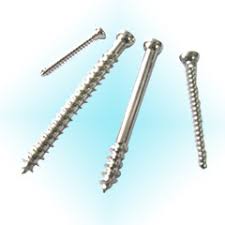
I didn't fully grasp the damage to my ankle until I visited the orthopedic surgeon. From the X-ray I'd seen in the emergency room, I thought I'd simply done a number on my tibula (the major weight-bearing bone).
Yes, it turned out, I had fractured my tibula, including breaking off the bottom "scoop." But I'd also broken my fibula. Moreover, I'd torn the connective tissue -- the interosseous ligament -- between the two bones. As eOrthopod explains:
The interosseous ligament lies between the tibia and fibula. (Interosseous means between bones.) The interosseus ligament is a long sheet of connective tissue that connects the entire length of the tibia and fibula, from the knee to the ankle.So I was going to need screws to put my tibia back together, a plate and screws to fix my fibula, and a couple longer screws to bridge/bind the ligament (when the ligament scarred shut, these screws would be removed; the rest of the hardware would stay). I would be getting surgical screws (implants) made of stainless steel or titanium (I'd requested adamantium -- like Wolverine's retractable claws -- to no effect).

When the surgeon was done with me, my ankle would look like this:

In medical lingo, I'd be receiving an ORIF -- Open Reduction Internal Fixation. Open Reduction refers to surgery (because they're literally opening you up) and Internal Fixation (though it sure sounds like a psychological condition) pertains to bone alignment/repair. Conquest Chronicles, a blog about the USC Trojans, states that
the goal of treating all ankle fractures is to re-position the bones to prevent the occurrence of arthritis. Some minor ankle fractures can be treated in a boot or a cast without surgery. The majority of ankle fractures, however, do require operative treatment. Surgery is performed with incision(s) on one or both sides of the ankle. Screws and/or a metal plate are inserted into the medial malleolus and the fibula in order to accurately restore or reduce the fracture alignment.According to the American Academy of Orthopaedic Surgeons, "In 2003, nearly 1.2 million people visited emergency rooms because of ankle problems." An article appearing on the website of an accident and injury law firm notes that
High-impact ankle injuries are especially dangerous if the bone breaks through the skin and is exposed to the air. The open wound lets bacteria in to contaminate the broken bone, greatly increasing the risk of infection. In such a case, you will be prescribed a course of antibiotics to stave off any infection.Thankfully, I'd been spared a compound fracture. However, I wasn't home free. As I noted in my earlier post about peripheral neuropathy, there can be a variety of complications associated with the break, the subsequent surgery, and the period of immobilization during recovery (among the most common -- nerve damage and muscle atrophy).
As I learned from netdoctor:
Fortunately, "You will be given injections of blood-thinners (heparin) after the operation to prevent a DVT."Another possible complication is the formation of clots in the deep veins (draining pipes for the blood) of your legs – deep vein thrombosis (DVT). This can happen in the initial days after the operation because you won’t be moving around much.
A piece of one of these clots can get detached and ‘travel’ all the way to the blood pipes of your lungs. There it can cause partial or complete obstruction of the blood vessels of the lungs, which can be lethal.
The morning of the surgery arrived. My wife and daughter drove me to the hospital. I was given a hospital gown. The nurse started an intravenous drip. They got me on a gurney. They wheeled me into the (freezing) OR. They placed me on the operating table. I caught a glimpse of my surgeon.

And then... lights out.
When I woke up, I felt like I was in the anteroom to heaven. A wash of white light, the disembodied voice of a nurse. Asking me, "What's your pain like, on a scale of one to ten?" I was given a painkiller for anything over "one."
As we know, all good, morphine-induced experiences must pass. Soon enough, I was sitting in a wheelchair, reunited with my family. Being pushed though the halls. Out to the parking lot. Out into the cold, harsh world.

I'm surprised you can still get a date with an ankle that looks like that. :)
ReplyDelete